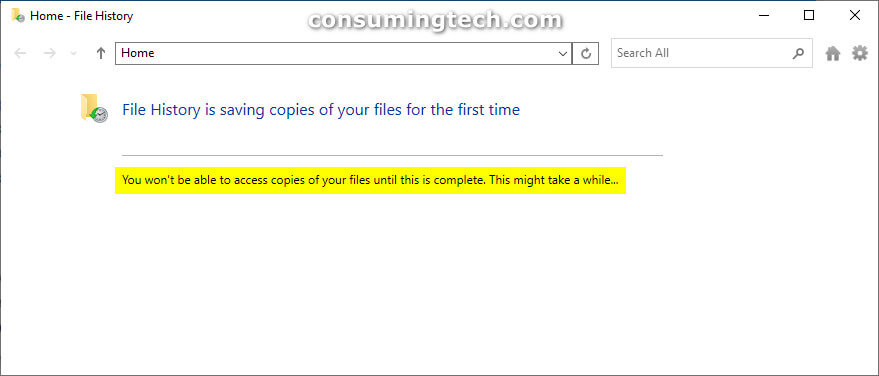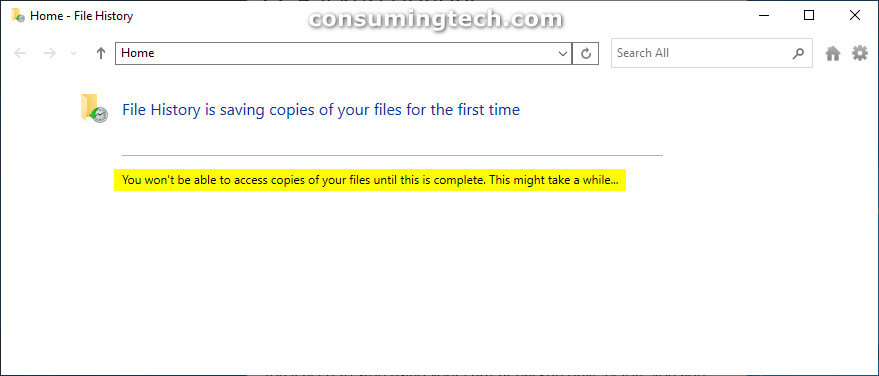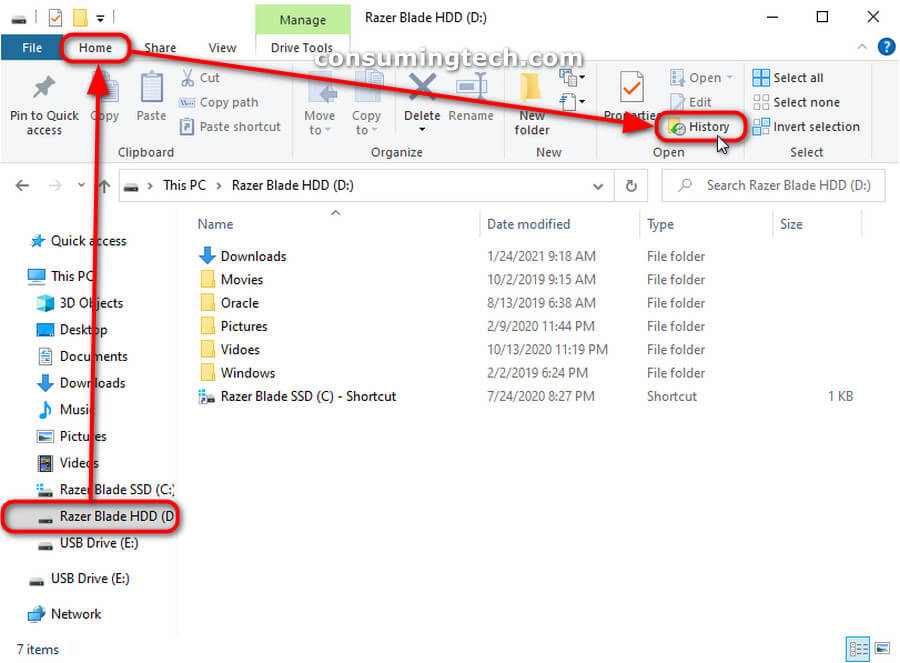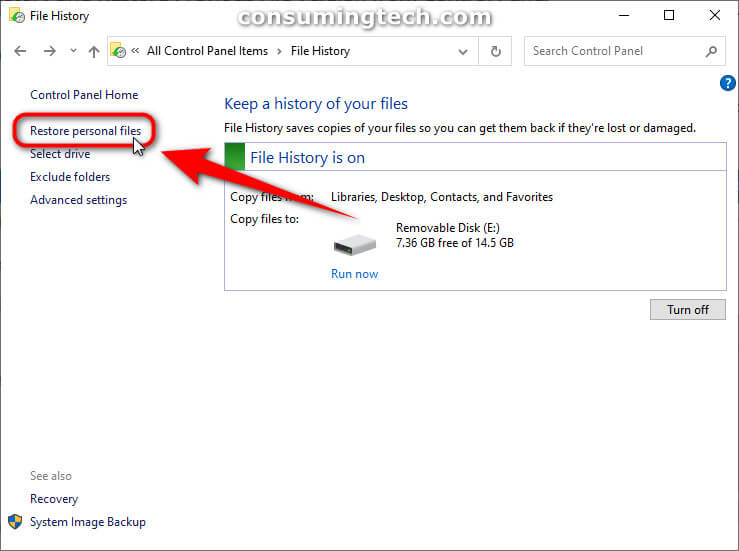Last Updated on December 24, 2022 by Mathew Diekhake
I have previously used File History to take automatic backups for my files and folders. I’m already familiar with turning File History on and allowing the automatic backups, as well as choosing how much time elapses between backups. Now I’m looking to restore those backups. Resolution:
Before Windows 8 was released, the Windows operating system had Backup and Restore (formerly Windows Backup and Restore Center) for taking backups. Microsoft stated that due to its low use, it would be deprecating the way users since Windows Vista had been taking backups via the traditional Backup and Restore; however, those using Windows 7 still could find the Windows 7 File Recovery Control Panel applet which allowed them to take similar backups.
File History is an application, that when turned on, will continually back up the files it finds on your desktop, in your libraries, in your Favorites folder, and your Contacts folder. If you leave File History on its default settings, it will back up these locations every hour, though you can change the amount of time you wish to elapse between backups to be as long as only once per day if you prefer. The backups can only occur for as long as you have the external hard drive or USB thumb drive connected to the computer; File History will not back up to the existing locations on the computer; it perceives them as useless locations to store backups since the point of a backup is in case your existing drives fail. File History will not ever erase files and folders that were previously saved to the drive; everything File History saves is saved to its own unique folder called “FileHistory.”
The following tutorial demonstrates how to restore files and folders from File History backups when you are using a version of the Windows 10 operating system.
Method One: How to Open File History and Restore Previous File Version via File Explorer
You can use Windows 10’s File Explorer for getting access to File History and then restoring the previous file version. Follow these guidelines for restoring previous file versions via File Explorer:
Note: There will be an automatic additional 26 characters added to the full path of the backup. The maximum full path that Windows 10 allows for is a total of 210 characters. This means any file with a path longer than 185 characters will not be backed up.
1. Open File Explorer. This tutorial shows you all the different ways in which you can open File Explorer when you are using a version of the Windows 10 operating system: How to Open File Explorer in Windows 10 [Tutorial]
2. Click on the Home tab, which is located on the File Explorer ribbon, and then click on the History icon. (Click to enlarge the screenshot below.)
Note: You will not necessarily see the Home tab on the ribbon from every location within File Explorer. For instance, clicking on This PC removes the ribbon and it is only when you have selected a drive or a folder location on the drive that you will begin to see the ribbon. This setup eventually makes sense when using the operating system because the ribbon only becomes useful when you are working with drives, but those opening File Explore purely as a gateway for restoring previous file versions must be wary of this.
You should notice left and right blue arrows beneath the files when viewing them within the File History window. This allows you to scroll through the files and choose which ones you would like to restore. Once you have found the files you want to be restored, click on the big green button with an anticlockwise arrow to restore them. Windows 10 has also made it possible to right-click on the same green button and choose the option to restore from its context menu. If you would like to restore the files to a specific location, then follow the same steps but instead select Restore to rather than just Restore from the context menu. This will then allow you to navigate using File Explorer to choose your desired location on the operating system, which includes the desktop and all the same location you would browse via File Explorer when saving your usual files.
Method Two: How to Open File History and Restore Previous File Version via Control Panel
You can use Windows 10’s Control Panel for getting access to File History and then restoring the previous file version. Follow these guidelines for restoring previous file versions via the Windows Control Panel:
Note: There will be an automatic additional 26 characters added to the full path of the backup. The maximum full path that Windows 10 allows for is a total of 210 characters. This means any file with a path longer than 185 characters will not be backed up.
1. Open the Control Panel in icons view. This tutorial shows you all the different ways in which you can open the Control Panel when you are using a version of the Windows 10 operating system: How to Open Control Panel in Windows 10 [Tutorial]
2. Click on the File History icon from the list of All Control Panel Items.
3. Click on Restore personal files from the left side of File History. (Click to enlarge the screenshot below.)
4. If this is your first time using File History, you will then get a message letting you know that File History is saving copies of your files for the first time; and that You won’t be able to access copies of your files until this is complete. (Click to enlarge the screenshot below.)

You should notice left and right blue arrows beneath the files when viewing them within the File History window. This allows you to scroll through the files and choose which ones you would like to restore. Once you have found the files you want to be restored, click on the big green button with an anticlockwise arrow to restore them. Windows 10 has also made it possible to right-click on the same green button and choose the option to restore from its context menu. If you would like to restore the files to a specific location, then follow the same steps but instead select Restore to rather than just Restore from the context menu. This will then allow you to navigate using File Explorer to choose your desired location on the operating system, which includes the desktop and all the same location you would browse via File Explorer when saving your usual files.
Method Three: How to Open File History and Restore Previous File Version via Settings
You can use Windows 10’s Settings application for getting access to File History and then restoring the previous file version. Follow these guidelines for restoring previous file versions via the Settings app:
Note: There will be an automatic additional 26 characters added to the full path of the backup. The maximum full path that Windows 10 allows for is a total of 210 characters. This means any file with a path longer than 185 characters will not be backed up.
1. Open the Settings app. This tutorial shows you all the different ways in which you can open the Settings app when you are using a version of the Windows 10 operating system: How to Open Settings in Windows 10 [Tutorial]
2. From the left side of the Update and Security menu, click on Backup, and then under Back up using File History click on the More options link. (Click to enlarge the screenshot below.)
3. Click on Restore files from a current backup. (Click to enlarge the screenshot below.)

4. If this is your first time using File History, you will then get a message letting you know that File History is saving copies of your files for the first time; and that You won’t be able to access copies of your files until this is complete. (Click to enlarge the screenshot below.)

You should notice left and right blue arrows beneath the files when viewing them within the File History window. This allows you to scroll through the files and choose which ones you would like to restore. Once you have found the files you want to be restored, click on the big green button with an anticlockwise arrow to restore them. Windows 10 has also made it possible to right-click on the same green button and choose the option to restore from its context menu. If you would like to restore the files to a specific location, then follow the same steps but instead select Restore to rather than just Restore from the context menu. This will then allow you to navigate using File Explorer to choose your desired location on the operating system, which includes the desktop and all the same location you would browse via File Explorer when saving your usual files.
That’s all.
Related Tutorials
- How to Backup and Restore Sticky Notes in Windows 10 [Tutorial]
- How to Exclude Folders from File History in Windows 10 [Tutorial]
- How to Change How Often to Save File History in Windows 10 [Tutorial]
- How to Automatically Create System Restore Point on Schedule in Windows 10 [Tutorial]
- How to See List of All Available System Restore Points in Windows 10 [Tutorial]
- How to Backup and Restore with Macrium Reflect [Tutorial]
- How to Reset Sticky Notes in Windows 10 from System Settings [Tutorial]
- How to Backup Files/Folders via File History in Windows 10 [Tutorial]
- How to Backup/Restore Network Shares and Permissions in Windows 10 [Tutorial]
- How to Change How Long File History Stores Backups in Windows 10 [Tutorial]
- How to Backup/Restore Sticky Notes App Settings in Windows 10 [Tutorial]
- How to Change Windows Backup Settings in Window 10 [Tutorial]



